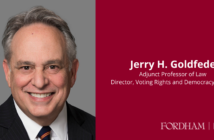Professor Abner S. Greene, Leonard F. Manning Professor of Law, remembers his time clerking (1987-1989) for Supreme Court Justice John Paul Stevens.
I met Justice Stevens in July of 1986, when he invited me to the Court to interview for a clerkship with him. I recall three main things about that interview — he was incredibly kind and unpretentious; we talked about his opinion in a case the Court had just decided (Bowsher v. Synar); and we talked about our beloved Cubs (him) and Mets (me). He had a baseball on his desk autographed by members of the Cubs team. I’m not sure if he hired me because he knew we could talk baseball together, but I guess it didn’t hurt!
My time clerking for Justice Stevens — July 1987 to January 1989 — was the job of a lifetime (with all due respect to my second-best job ever, here at Fordham Law School). Justice Stevens interacted with his law clerks on a daily basis, talking law in his office and ours. Away from chambers, the Justice had an active social life that he would tell us some about — flying a private plane, playing bridge and golf, and playing tennis. He would often arrive at chambers fresh from an early morning tennis match, regaling us with the tale of his victory (or, less often, a loss).
The law talk was extraordinary. He is clearly the most brilliant person I’ve ever met (and I’d guess his other clerks share that view). He would write the first drafts of his opinions, then give them to us for editing. That editing would sometimes be extensive (if he gave us a bare-bones draft); sometimes less so (if he gave us a more complete draft). Because of his steel-trap mind, he didn’t require bench memos from us — he read all the briefs (including the sometimes voluminous amicus briefs), and remembered all the arguments contained therein. We did, though, give him memos on all of the cert petitions — he didn’t participate in the “cert pool,” wanting to exercise his independent judgment (with our assistance) on each petition. We also worked closely with him on the various last-minute death penalty appeals that came to the Court; I recall that as the most emotionally draining part of the job.
I worked on various cases with Justice Stevens; I suppose the most famous one was City of Richmond v. J.A. Croson Co. (in which he wrote a fascinating concurring opinion on when affirmative action plans should be permitted and when not). My favorite case with him was Pittston Coal Group v. Sebben — an under-the-radar case (well, except for those directly affected) that pitted Justice Stevens’ contextual/legislative history view of statutory and administrative interpretation against Justice Scalia’s “plain meaning” view. I remember fondly Justice Stevens getting his hands dirty, as it were — and me along with him — digging through legislative and administrative history in an effort to figure out what happened in the drafting of the complex statutory/administrative scheme at issue in the case. Justice Scalia prevailed on that one (and I got to know now-Harvard-Law Dean John Manning, who was the clerk for Justice Scalia on that case); the Stevens-Scalia battle over interpretive methods continued (and still does, even after those two men have passed).
Much has been written about Justice Stevens’ jurisprudence (some in the Fordham Law Review 2005 symposium, published in 2006, that I helped organize, with now-Cornell-Law Dean Eduardo Penalver). I’ll add just this — Justice Stevens cared about reasons. He wanted the government — which exercises such extraordinary power — to turn square corners in the reasons it offers for its coercive actions. Reasons that are biased, partial, animus-based, were subject to the Justice’s critical stance. When he said there is only one Equal Protection Clause, and that it requires the government to govern impartially, he really meant that for the Constitution as a whole.
In the years that followed my clerkship, I stayed in good touch with Justice Stevens. I would sometimes visit him in chambers when I was in D.C., including memorably in the spring of 2010 after he had announced his upcoming retirement but before President Obama had nominated my old friend Elena Kagan to fill Justice Stevens’ seat. I sent the Justice all my articles and the two books I published, and he would sometimes write back, agreeing or disagreeing with my principal arguments. Once I sent him the Bar Mitzvah talk given by the son of good friends of mine, because the talk was about capital punishment and I thought the Justice would appreciate it. He did, and wrote back a congratulatory letter that the young man could see. And once when I was doing a March baseball spring training tour of Florida, I had a drink with Justice Stevens on the balcony of his condo in Ft. Lauderdale, overlooking the Atlantic (at least that’s how I remember it! maybe it was indoors :).
Throughout, Justice Stevens was brilliant yet humble, forceful yet kind, always interested in what I was doing and in talking law … and baseball. He was a hero to me and to the many others whose lives he touched. It was my great honor and privilege to serve the nation by clerking for this great patriot, Justice John Paul Stevens.




